Publications
Design Study of LineSets, a Novel Set Visualization Technique
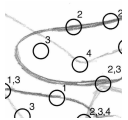 Alper B., Henry-Riche N., Ramos G., Czerwinski
M.- In IEEE TVCG (Proceedings of Infovis 2011), to appear.
Alper B., Henry-Riche N., Ramos G., Czerwinski
M.- In IEEE TVCG (Proceedings of Infovis 2011), to appear.
We present LineSets, a novel visual representation of sets consisting on a continuous curve connecting all elements of a set. We demonstrate that this technique has advantages over concave shapes techniques present an application of our technique in the context of a data analysis task in a map.
Air pointing:
Design and evaluation of spatial target acquisition with
and without visual feedback
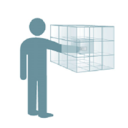 Cockburn,
A. , Quinn P., Gutwin C., Ramos G., Looser J.
- Int. J. Human-Computer Studies 69
Cockburn,
A. , Quinn P., Gutwin C., Ramos G., Looser J.
- Int. J. Human-Computer Studies 69
We explore the design space for air pointing interactions, and present a framework that helps designers understand input dimensions and resulting interaction qualities. We test our framework by designing and comparing three air pointing techniques. Our results and the organising framework provide a foundation for innovation and understanding of air pointing interaction.
ImageFlow: Streaming Image Search 

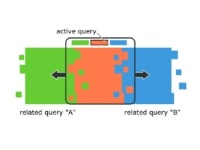 Jampani V.,
Ramos
G., Drucker S. - Microsoft Research Technical Report MSR-TR-2010-148
Jampani V.,
Ramos
G., Drucker S. - Microsoft Research Technical Report MSR-TR-2010-148
ImageFlow is a novel image search user interface that explores a different alternative to the traditional grid/list presentation of image search results. ImageFlow shows image results where we map semantic features to the canvas' spatial dimensions in a way that allows for several levels of en-gagement – from passively viewing a stream of images, to seamlessly navigating through the semantic space and actively collecting images for sharing and reuse.
Content-Aware Dynamic Timeline for Video Browsing 
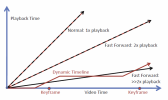 Pongnumkul S., Wang J., Ramos G., Cohen M.
- UIST 2010
Pongnumkul S., Wang J., Ramos G., Cohen M.
- UIST 2010
When videos have more frames than pixels in the player's timeline slider, frames become inaccessible and scrolling actions cause sudden jumps in a video’s continuity. We propose a content-aware dynamic timeline control that decouples video speed and playback speed and allow salient shots to be presented at an intelligible speed.
Mobile Task Flow in Context: A Screen Shot Study of Smartphone Usage
![]()
![]()
Karlson A., Iqbal S., Meyers B., Ramos G., Lee K., Tang J. - CHI 2010
Using a survey and a screenshot-based diary study we investigated the types of barriers people face when performing tasks on their mobile phones, the ways they follow up with such suspended tasks, and how frustrating the experience of task disruption is for mobile users. We distill a classification of barriers the completion of mobile tasks and discuss how the guidelines can be extended to mitigate disruptions to mobile taskflow.
Visual Snippets: Summarizing Web Pages for Search and Revisitation
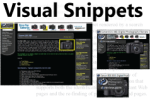
![]()
Teevan J., Cutrell E., Fisher D., Drucker S., Ramos G., André P., Hu C. - CHI 2009.
People regularly interact with different representations of Web pages. Previous research has explored how to best represent Web pages in support of specific task types, but, as we find in this paper, consistency in representation across tasks is also important. We explore how different representations are used in a variety of contexts, and present a compact representation that supports both the identification of new, relevant Web pages and the re-finding of previously viewed pages.
An Exploration of Pen Rolling for Pen-based Interaction.



![]()
Bi X., Moscovich T., Ramos G., Balakrishnan R., Hinckley K. - UIST 2008.
We explore pen rolling as a supporting input modality for pen-based interaction. We have identified two important parameters: a) what separate intentional pen rolling for the purpose of interaction from incidental pen rolling caused by regular writing and drawing, and b) the range within which accurate and timely intentional pen rolling interactions can occur. We investigate the design space of rolling-based interaction techniques, through a number of scenarios where pen rolling interactions can be useful.
DimP: Video Browsing by Direct Manipulation 

![]() Dragicevic P., Ramos G., Bibliowicz J., Nowrouzezahrai D., Balakrishnan
R. and Singh K.
Dragicevic P., Ramos G., Bibliowicz J., Nowrouzezahrai D., Balakrishnan
R. and Singh K.
-
CHI 2008.
We present a method for browsing videos by directly dragging their content. This method brings the benefits of direct manipulation to an activity typically mediated by widgets. We show that this method can out-perform the traditional seeker bar in video browsing tasks that focus on visual content rather than time.
More detailed information about the project, can be found here. You can watch the 1 minute or the 4 minutes videos on ![]() .
.
OpenMessenger:
Gradual Initiation of Interaction for Distributed Workgroups 

![]()
![]() Birnholtz J., Gutwin C., Ramos G., Watson M.
- CHI 2008.
Birnholtz J., Gutwin C., Ramos G., Watson M.
- CHI 2008.
We have developed a prototype message system that adds the idea of gradual initiation of interaction to on-line communication. This system provides both multiple levels of awareness about people, and notification to those about whom information is being gathered. We argue that this system allows people to negotiate interaction in a richer fashion than is possible with any other current messaging system.
Pointing Lenses:
Facilitating Stylus Input through Visual- and Motor-Space Magnification 


![]() Ramos, G., Cockburn, A., Beaudouin-Lafon, M. Balakrishnan,
R. - CHI 2007.
Ramos, G., Cockburn, A., Beaudouin-Lafon, M. Balakrishnan,
R. - CHI 2007.
Pointing lenses help users acquire and select targets with a stylus by presenting them with an enlarged visual and interaction area. Our experimental results not only show that participants find all pointing lenses beneficial for targets smaller than 5 pixels, but they also suggest that this benefit may extend to larger targets as well.
Pressure Marks 

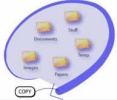
![]() Ramos, G., Balakrishnan,
R. - CHI 2007.
Ramos, G., Balakrishnan,
R. - CHI 2007.
Pressure marks are pen strokes where the variations in pressure make it possible to indicate both a selection and an action simultaneously. Pressure marks are a viable technique that allow users to perform faster selection-action interactions than with a combination of lassos and pigtails. Pressure marks can also be incorporated into a number of existing and new interaction techniques.
Phosphor:
Explaining Transitions in the User Interface Using Afterglow Effects 

![]() Baudisch, P., Tan, D., Collomb, M., Robbins, D., Hinckley, K., Agrawala, M., Zhao, S., and Ramos, G.,
- ACM UIST 2006.
Baudisch, P., Tan, D., Collomb, M., Robbins, D., Hinckley, K., Agrawala, M., Zhao, S., and Ramos, G.,
- ACM UIST 2006.
Phosphor objects show the outcome display changes instantly. At the same time they explain these change in retrospect. We present a framework of transition designs for phospor widgets, icons, and objects in drawing programs. Our evaluations of phosphor objects reveal significant performance benefits for phosphor objects when compared with traditional techniques.
Tumble! Splat!:
Helping Users Access and Manipulate Occluded Content in 2D Drawings
![]() Ramos, G., Robertson,
G., Czerwinsky, M., Tan, D., Baudisch, P., Hinckley, K., Agrawala,
M., Robbins, D. - AVI 2006.
Ramos, G., Robertson,
G., Czerwinsky, M., Tan, D., Baudisch, P., Hinckley, K., Agrawala,
M., Robbins, D. - AVI 2006.
Accessing and manipulating occluded content in 2D drawings can be difficult. We introduce Tumbler and Splatter, two new tools to help users in these tasks. We present the results of a study that contrasts these two new techniques against a traditional scene index used in most drawing applications.
Zliding:
Zooming and Sliding for High-Precision Parameter Manipulation 

Ramos, G., Balakrishnan,
R. - UIST 2005.
Precise parameter manipulation tasks typically require adjustment of the scale of manipulation in addition to the parameter itself. We introduces the notion of Zoom Sliding (Zliding) for fluid integrated manipulation of scale via pressure input while parameter manipulation within that scale is achieved via x-y cursor movement. We also present the Zlider, a widget that instatiates the Zliding concept.
Design and Analysis of Delimiters for
Selection-Action Pen Gesture Phrases in Scriboli 

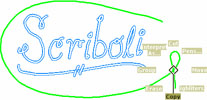 Hinckley, K., Baudisch, P., Ramos,
G., Guimbretiere, F. - CHI 2005.
Hinckley, K., Baudisch, P., Ramos,
G., Guimbretiere, F. - CHI 2005.
We present a quantitative analysis of delimiters for pen gestures. Also, we introduce the Pigtail, a novel interaction technique that uses a small loop to delimit a gesture. We show how Pigtail supports integrated scope selection, command activation, and direct manipulation all in a single fluid pen gesture.
Stitching: Pen Gestures that Span Multiple Displays 
Hinckley, K., Ramos, G., Baudisch, P., Guimbretiere, F. and Smith, M.
- AVI 2004.
Stitching allows users to combine pen-operated mobile devices by using pen gestures that span multiple displays. To stitch, a user starts moving the pen on one screen, crosses over the bezel, and finishes the stroke on the screen of a nearby device. We demonstrate different applications that take advantege of stitching and also discuss design issues that arise from proxemics, that is, the sociological implications of users collaborating in close quarters.
Pressure Widgets 
 Ramos,
G., Boulos, M., Balakrishnan, R. - CHI 2004.
Ramos,
G., Boulos, M., Balakrishnan, R. - CHI 2004.
Current GUIs assume that input devices only provides position and button press information. We explore the design space of using the pressure sensing capabilities of pens to operate multi-state widgets. Based on experimental results, we discuss implications for the design of pressure sensitive widgets. Finally, we propose a taxonomy of pressure widgets, along with a set of concept sketches of various widget designs.
Fluid Interaction Techniques for the Control and
Annotation of Digital Video 

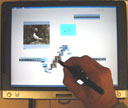 Ramos,
G., Balakrishnan, R. - UIST 2003.
Ramos,
G., Balakrishnan, R. - UIST 2003.
We explore new techniques supporting the fluid navigation, segmentation, and annotation of digital videos. These techniques are developed within a prototype designed for use with pressure-sensitive digitizer tablets. We show how pressure can expand the vocabulary of gestures available to users. Finally, we elaborate on how annotations referring to objects that are temporal in nature, such as video, can be thought of as links, and fluidly constructed, visualized and navigated.
Other Publications
Interpolation of Surfaces over Scattered Data 
 Ramos, G., Enright, W.
- IASTED, VIIP 2002.
Ramos, G., Enright, W.
- IASTED, VIIP 2002.
We investigate the performance of DEI, an algorithm that computes off-mesh approximations of PDE solutions, and can also be used as a technique for scattered data interpolation and surface representation.We also present ADEI an extension to DEI. We measure ADEI’s performance using different sets of scattered data and test functions and compare ADEI against two methods from the collection of ACM algorithms: Algorithms 752 and 790. The results show that ADEI is better than, if not comparable to, the best of the compared scattered data interpolation techniques.
Stitching:
Connecting Wireless Mobile Devices with Pen Gestures 

![]() Hinckley, K., Ramos, G.,
Baudisch, P., Guimbretiere, F.and Smith, M. - CSCW 2004.
Hinckley, K., Ramos, G.,
Baudisch, P., Guimbretiere, F.and Smith, M. - CSCW 2004.
Stitching allows users to combine pen-operated mobile devices by using pen gestures that span multiple displays. To stitch, a user starts moving the pen on one screen, crosses over the bezel, and finishes the stroke on the screen of a nearby device. We demonstrate different applications that take advantege of stitching and also discuss design issues that arise from proxemics, that is, the sociological implications of users collaborating in close quarters.
Fingerprint
Image Compression Using Wavelets:
A Comparison with JPEG 
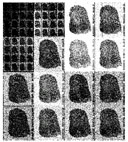 Ramos, G.
- IASTED Signal and Image Processing Conference, SIP99.
Ramos, G.
- IASTED Signal and Image Processing Conference, SIP99.
We performed a study and later comparison, using a large dataset, between the FBI's fingerprint image compression standard (WSQ) and an optimized version of JPEG. We achieved this optimization by adapting JPEG's quantization table using a new bit allocation scheme tuned by the fingerpring image set. This study shows conclusively the superior performance of WSQ over traditional image compresion methods, specifically JPG.